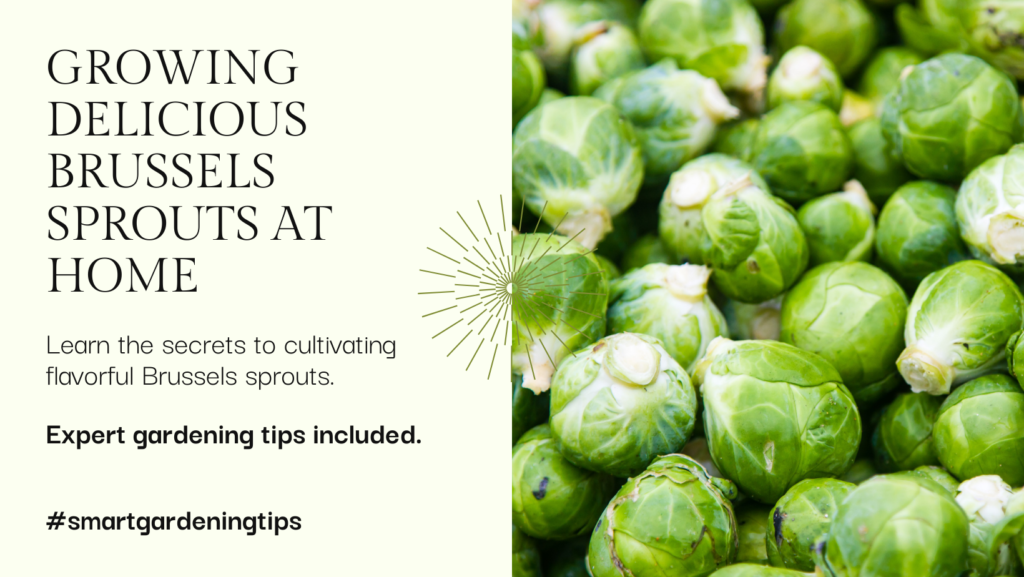
Welcome to the world of delicious Brussels sprouts! Cultivating your own flavorful and tasty sprouts can be a rewarding and satisfying experience. Not only will you be able to enjoy the superior taste and freshness of homegrown Brussels sprouts, but you’ll also have the opportunity to explore various cooking techniques and mouthwatering recipes that will elevate these tiny cabbages to new heights of culinary delight.
In this comprehensive guide, we will take you through every step of the process, from selecting the right Brussels sprouts varieties to harvesting and storing them to maximize their flavor. We’ll also delve into cooking techniques that will enhance the taste of your sprouts and explore the vital role growing conditions and organic cultivation methods play in developing their flavors.
Whether you’re a seasoned gardener or a beginner with a green thumb, this article will provide you with all the information you need to cultivate delicious Brussels sprouts that will impress your taste buds and satisfy your culinary desires.
Key Takeaways:
- Discover the secrets to cultivating flavorful Brussels sprouts at home.
- Learn how to select the right varieties and optimize growing conditions for maximum taste.
- Find out when and how to harvest and store Brussels sprouts to preserve their flavor and freshness.
- Explore cooking techniques and delicious recipes to make the most out of your homegrown sprouts.
- Uncover the nutritional benefits of Brussels sprouts and their contribution to a healthy diet.
Introduction to Cultivating Tasty Brussels Sprouts
Welcome to the exciting world of Brussels sprouts cultivation! Whether you’re a seasoned gardener or just getting started, growing your own Brussels sprouts can be a rewarding experience that pays off in flavor and freshness. In this section, we’ll provide an introduction to cultivating tasty Brussels sprouts and explore the many benefits of growing these delicious vegetables in your own backyard.
Brussels sprouts, known for their miniature cabbage-like appearance, are packed with nutrients and offer a unique flavor profile that can be truly enjoyable when prepared properly. By cultivating your own Brussels sprouts, you have full control over their growing conditions, ensuring that they receive the necessary care and attention to develop their best taste.
One of the primary advantages of growing Brussels sprouts at home is the ability to harvest them at peak freshness. Unlike store-bought varieties that may have spent days or weeks in transit, your homegrown sprouts can go straight from the garden to your table, maximizing their flavor potential.
Experience the satisfaction of cultivating your own Brussels sprouts and unlock a world of culinary possibilities. From tender roasted sprouts to flavorful stir-fries, you’ll be amazed at the versatility and taste that homegrown Brussels sprouts bring to your meals.
In addition to the superior taste, growing your own Brussels sprouts allows you to experiment with different varieties that may not be readily available in stores. You can choose from a wide range of options, including heirloom varieties known for their exceptional taste and unique characteristics.
By taking the reins and cultivating your own Brussels sprouts, you become part of the journey from seed to plate, witnessing firsthand the transformative process of nurturing a tiny seed into a thriving vegetable. Let’s dive into the fascinating world of Brussels sprouts cultivation, learn the skills you need, and unleash the full flavor potential of these delectable vegetables!
Selecting the Right Brussels Sprouts Varieties
When it comes to cultivating tasty Brussels sprouts, selecting the right varieties is key. Different varieties offer varying flavors and characteristics, so it’s important to consider a few key factors when making your choice. Here, we’ll explore the key factors to consider when choosing Brussels sprouts varieties and highlight some popular options known for their exceptional taste.
Key Factors to Consider
When selecting Brussels sprouts varieties for your garden, there are a few important factors to keep in mind:
- Climate suitability: Ensure that the variety you choose is well-suited to your specific climate. Brussels sprouts thrive in cooler temperatures and may not fare well in extreme heat or cold.
- Days to maturity: Consider the time it takes for the variety to reach maturity. Some varieties may mature faster than others, allowing you to enjoy your harvest sooner.
- Plant size: Brussels sprouts plants can vary in size, with some varieties growing taller than others. Be sure to select varieties that fit well within your garden space.
- Disease resistance: Look for varieties that are known for their disease resistance. This can help ensure healthy plants and a successful harvest.
- Taste profile: Finally, consider the flavor profile of the Brussels sprouts variety. Some are sweeter, while others have a more robust and nutty taste. Choose a variety that aligns with your taste preferences.
Popular Brussels Sprouts Varieties for Taste
Now that you know the key factors to consider, let’s explore some popular Brussels sprouts varieties known for their exceptional taste:
| Variety | Taste Profile |
|---|---|
| Teyah | Delicate and sweet |
| Hestia | Buttery and nutty |
| Darkmar 21 | Earthy and flavorful |
| Jade Cross | Slightly bitter with a hint of sweetness |
These varieties are renowned for their taste and are sure to elevate your culinary creations. Consider experimenting with different varieties to discover your personal favorite. Remember, selecting the right Brussels sprouts varieties is the first step towards cultivating delicious and flavorful sprouts.
Planting and Caring for Brussels Sprouts
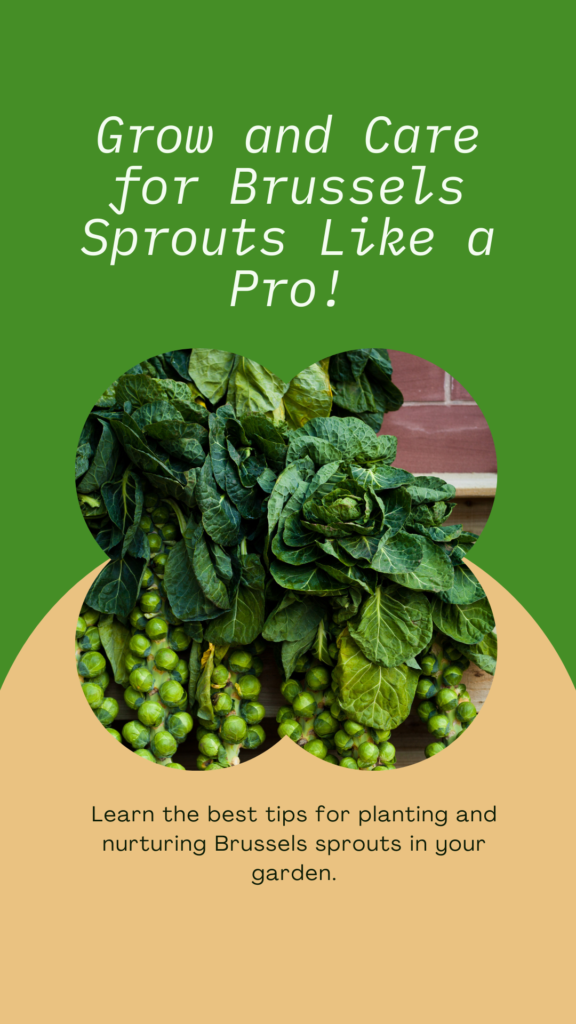
Once you’ve selected the perfect Brussels sprouts variety for your garden, it’s time to get your hands dirty and start planting! Follow these steps to plant Brussels sprouts in your garden and ensure proper maintenance for healthy and tasty sprouts.
Step 1: Choose the Right Location
Brussels sprouts thrive in cool climates, so choose a spot in your garden that receives full sun and has well-draining soil. Make sure the area is protected from strong winds, as they can damage the plants.
Step 2: Prepare the Soil
Before planting, prepare the soil by removing any weeds and loosening it with a garden fork or tiller. Brussels sprouts prefer a soil pH between 6.0 and 7.5. If needed, amend the soil with compost or aged manure to improve its fertility and drainage.
Step 3: Start Seeds Indoors
If you’re starting from seeds, sow them indoors 6-8 weeks before the last frost date in your area. Plant them in seed trays or small pots filled with seed starting mix and keep them in a warm location with plenty of sunlight. Once the seedlings have grown to about 2-3 inches in height, they are ready to be transplanted outdoors.
Step 4: Transplant Seedlings
When the danger of frost has passed and the seedlings are strong enough, it’s time to transplant them outdoors. Dig holes in the prepared soil, spacing them about 18-24 inches apart. Gently remove the seedlings from their containers, being careful not to damage the roots, and place them in the holes. Fill the holes with soil and firm it gently around the plants.
Step 5: Water and Mulch
After transplanting, water the seedlings thoroughly to help them establish their roots. Keep the soil consistently moist but avoid overwatering, as Brussels sprouts prefer evenly moist soil. Apply a layer of organic mulch around the plants to help retain moisture, suppress weeds, and regulate soil temperature.
Step 6: Provide Proper Care
Fertilize your Brussels sprouts plants every 4-6 weeks with a balanced organic fertilizer to ensure they receive the nutrients they need. Monitor the soil moisture regularly and water whenever it feels dry to the touch. Additionally, remove any weeds that compete for nutrients and space.
Step 7: Support and Pruning
As your Brussels sprouts plants grow taller, they may need support to prevent toppling over. Install stakes or cages around the plants and gently tie them as they grow. Trim any yellow or damaged leaves to promote air circulation and prevent the spread of diseases.
Step 8: Harvesting
Brussels sprouts are ready to be harvested when the buds are firm, green, and about 1-2 inches in diameter. Start harvesting from the bottom of the plants when the lower sprouts are fully developed. Simply twist or cut the sprouts off the stalk, leaving the leaves intact above. Harvesting can continue as long as the plants produce new sprouts.
By following these steps to plant Brussels sprouts in your garden and practicing proper maintenance, you can enjoy a bountiful harvest of healthy and tasty sprouts. Now, let’s move on to the next section, where we’ll explore the best practices for harvesting and storing Brussels sprouts.
Harvesting and Storing Brussels Sprouts
Once your Brussels sprouts have reached maturity and are ready to harvest, it’s important to know the best practices for harvesting them at the peak of flavor. By following these tips, you’ll be able to enjoy the freshest and most delicious Brussels sprouts straight from your garden.
Harvesting Brussels Sprouts
To determine if your Brussels sprouts are ready for harvest, look for firm, compact sprouts that have reached a desirable size. The ideal size will depend on the specific variety you are growing, but a general rule of thumb is to wait until the sprouts are about 1 to 2 inches in diameter. Avoid harvesting sprouts that have opened up or have loose leaves.
When harvesting, it’s best to use a sharp knife or pruning shears to cut the sprouts from the main stem. Start at the bottom of the stalk and work your way up, harvesting the larger, lower sprouts first. Leave the smaller sprouts at the top to continue growing and maturing.
Remember to only harvest the number of sprouts you plan to use immediately or within a few days to maintain their optimal flavor and freshness.
Tips for Storing Brussels Sprouts
To extend the shelf life of your harvested Brussels sprouts and keep them tasting their best, proper storage is key. Here are some tips:
- Remove any loose or damaged leaves from the sprouts.
- Store the sprouts in a perforated plastic bag or a breathable container in the refrigerator. This will help maintain the sprouts’ freshness while allowing excess moisture to escape.
- Do not wash the sprouts before storing, as moisture can accelerate spoilage.
- For longer storage, blanch the Brussels sprouts by briefly immersing them in boiling water and then transferring them to an ice bath. Once cooled, drain and package the blanched sprouts in airtight containers or freezer bags. Frozen Brussels sprouts can be stored for up to 1 year.
By following these best practices for harvesting and storing Brussels sprouts, you can ensure that the taste and freshness of your homegrown sprouts are preserved for as long as possible. Now that you know how to harvest and store them, it’s time to explore the delicious ways to cook and enjoy your Brussels sprouts!
| Tip | Description |
|---|---|
| 1 | Remove any loose or damaged leaves from the sprouts. |
| 2 | Store the sprouts in a perforated plastic bag or a breathable container in the refrigerator. This will help maintain the sprouts’ freshness while allowing excess moisture to escape. |
| 3 | Do not wash the sprouts before storing, as moisture can accelerate spoilage. |
| 4 | For longer storage, blanch the Brussels sprouts by briefly immersing them in boiling water and then transferring them to an ice bath. Once cooled, drain and package the blanched sprouts in airtight containers or freezer bags. Frozen Brussels sprouts can be stored for up to 1 year. |
Cooking Delicious Brussels Sprouts Dishes
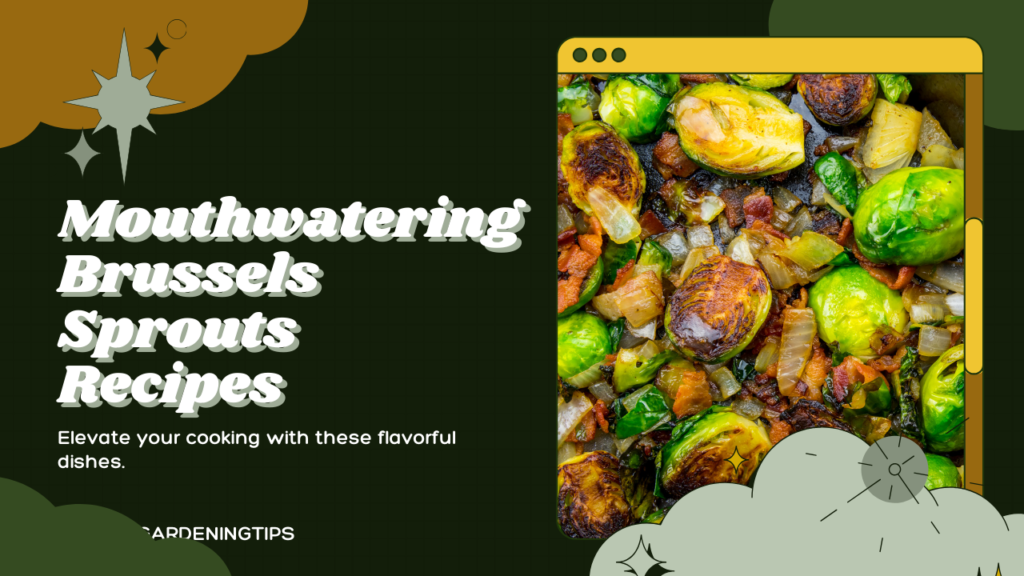
Now that you have successfully cultivated and harvested your homegrown Brussels sprouts, it’s time to explore the exciting world of cooking these flavorful gems. With the right cooking techniques and creative recipes, you can elevate the taste of your Brussels sprouts dishes to a whole new level.
To make the most out of your homegrown Brussels sprouts, it’s important to consider cooking techniques that enhance their natural flavors. One popular technique is roasting. Roasting Brussels sprouts caramelizes their outer leaves, giving them a delightful sweetness and a crispy texture. Simply toss the sprouts with olive oil, salt, and pepper, then spread them out on a baking sheet and roast in a preheated oven at 400°F for about 25-30 minutes, or until they are tender and slightly browned.
In addition to roasting, you can also try sautéing Brussels sprouts. Sautéing them in a skillet with butter or olive oil helps to bring out their nutty flavors. For extra zest, add garlic, lemon juice, or your favorite herbs and spices. Sauté the sprouts over medium-high heat until they are tender and lightly browned, stirring occasionally.
“Roasting Brussels sprouts caramelizes their outer leaves, giving them a delightful sweetness and a crispy texture.”
Creative and Tasty Recipes
Looking to venture beyond traditional preparations? Try these creative and tasty recipes that will showcase the versatility of Brussels sprouts:
- Brussels Sprouts Gratin: This indulgent dish combines roasted Brussels sprouts with a creamy béchamel sauce, topped with a generous layer of cheese and breadcrumbs.
- Honey Roasted Brussels Sprouts with Balsamic Glaze: This recipe adds a touch of sweetness with honey and a tangy twist with a drizzle of balsamic glaze, creating a perfect balance of flavors.
- Brussels Sprouts Salad with Cranberries and Pecans: This refreshing salad combines thinly sliced raw Brussels sprouts with dried cranberries, toasted pecans, and a tangy vinaigrette dressing.
These recipes are just the beginning – feel free to experiment and let your culinary creativity shine. Don’t be afraid to combine Brussels sprouts with other ingredients, such as bacon, mushrooms, or even fruits like apples and pears, to create unique and delicious flavor combinations.
Enhancing the Flavor of Brussels Sprouts
Aside from different cooking techniques and recipes, there are additional ways to enhance the flavor of your Brussels sprouts dishes. Try pairing them with complementary ingredients like garlic, lemon, parmesan cheese, or even a drizzle of balsamic reduction. These additions can elevate the taste profile and bring out the best in your homegrown Brussels sprouts.
Remember, the key to cooking delicious Brussels sprouts dishes lies in experimenting and finding what works best for your taste preferences. So go ahead, get creative in the kitchen, and enjoy the flavorsome rewards of your homegrown Brussels sprouts!
Optimizing Growing Conditions for Flavorful Brussels Sprouts
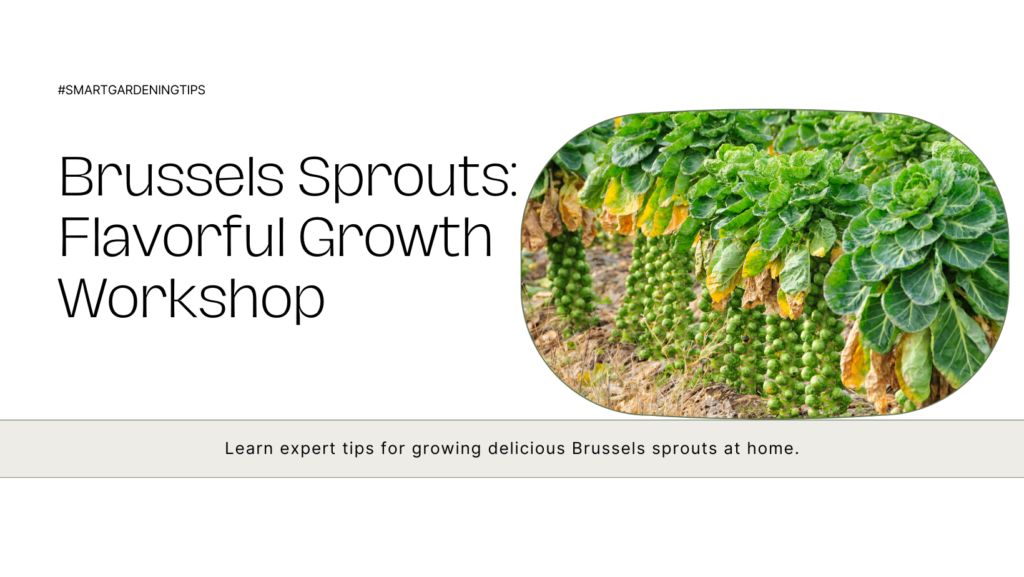
When it comes to cultivating delicious Brussels sprouts, providing the right growing conditions is essential. The flavors and taste of Brussels sprouts can be greatly influenced by their environment, so it’s important to optimize their growing conditions to maximize their flavor potential.
Here are some key factors to consider:
- Temperature: Brussels sprouts thrive in cool weather, ideally between 45°F and 75°F (7°C – 24°C). They can withstand light frost, which actually enhances their flavor. However, temperatures above 80°F (27°C) can cause the sprouts to develop a strong, bitter taste.
- Sunlight: Brussels sprouts require full sun exposure to develop their best flavors. Make sure to choose a location in your garden where they will receive at least 6 hours of direct sunlight each day.
- Soil: Well-draining soil with a pH range of 6.5 to 7.5 is ideal for Brussels sprouts. Prepare the soil by adding organic matter, such as compost or aged manure, to improve drainage and provide essential nutrients. Ensuring the soil is rich in nutrients will contribute to the development of flavorful sprouts.
- Water: Brussels sprouts need consistent moisture throughout their growth period. Water them regularly, aiming for about 1 to 1.5 inches per week. Mulching around the plants can help retain moisture and prevent weed growth while also regulating soil temperature.
- Spacing: Proper spacing is crucial for healthy growth and optimal flavor. Brussels sprouts should be planted 24 to 36 inches apart to allow adequate airflow and prevent the accumulation of excess moisture, which can lead to disease and reduce flavor.
- Fertilization: To promote robust growth and flavorful sprouts, feed your Brussels sprouts with a balanced organic fertilizer before planting and during the growing season. Look for a fertilizer specifically formulated for brassicas, as they have specific nutrient requirements.
Proper growing conditions are the foundation for flavorful Brussels sprouts. By paying attention to factors like temperature, sunlight, soil quality, water, spacing, and fertilization, you can optimize the growth process and enjoy sprouts with exceptional taste and tenderness.
Remember, providing the right growing conditions is just the beginning. The cultivation process continues in the next section, where we’ll explore how organic cultivation methods can further enhance the flavor of Brussels sprouts.
Enhancing Flavor Through Organic Cultivation Methods
When it comes to cultivating Brussels sprouts with exceptional flavor, organic methods can make a significant difference. By harnessing the power of nature and avoiding harmful chemicals, you can enhance the taste and quality of your homegrown sprouts. Here are some tips for incorporating organic cultivation methods into your practices:
1. Soil Enrichment
Start by enriching your soil with organic matter such as compost or well-rotted manure. This will provide essential nutrients and create a thriving environment for your Brussels sprouts to grow. Avoid synthetic fertilizers, as they can lead to imbalances and diminish the natural flavors of the sprouts.
2. Crop Rotation
Implement crop rotation techniques to prevent soil-borne diseases and maintain soil health. By changing the location of your Brussels sprouts each year, you reduce the risk of pests and diseases, resulting in healthier and more flavorful plants.
3. Natural Pest Control
Avoid chemical pesticides and opt for natural pest control methods instead. Introduce beneficial insects like ladybugs and lacewings to prey on harmful pests. Interplanting with companion plants such as marigolds or herbs can also repel unwanted insects, preserving the flavor of your Brussels sprouts.
4. Weed Management
Maintain a weed-free environment around your Brussels sprouts to prevent competition for nutrients and water. Use organic mulch or hand-pull weeds to avoid the use of herbicides that can affect the taste of your sprouts.
5. Watering Techniques
Water your Brussels sprouts consistently and deeply to ensure they receive an adequate water supply. Avoid overwatering, as this can lead to waterlogged soil and negatively impact the flavor. Mulching around the plants can help retain moisture and regulate soil temperature.
6. Timing for Harvest
Harvest your Brussels sprouts at the peak of maturity to retain their optimal flavor. The timing will depend on the specific variety you’re growing. Taste tests can help determine the perfect moment to pick your sprouts and savor the flavors they offer.
By implementing these organic cultivation methods, you can enhance the natural flavors of your Brussels sprouts, creating a delightful addition to your culinary creations. Embrace the power of organic practices and enjoy the full potential of your homegrown bounty.
Common Pests and Diseases Affecting Brussels Sprouts
Growing Brussels sprouts can be a rewarding experience, but like any plant, they are susceptible to pests and diseases that can hinder their growth and flavor. In this section, we will discuss some common pests and diseases that may affect your Brussels sprouts and provide strategies for prevention and treatment.
Pests:
1. Aphids: Aphids are small insects that feed on the sap of Brussels sprouts plants, causing curling leaves, stunted growth, and the presence of honeydew. To control aphids, you can try introducing natural predators like ladybugs or spraying a solution of water and mild dish soap on the affected plants.
2. Cabbage Loopers: Cabbage loopers are green caterpillars that can chew through Brussels sprouts leaves, resulting in ragged-looking foliage. Handpicking the caterpillars off the plants or using organic insecticides can help manage their population.
3. Cabbage Root Maggots: Cabbage root maggots are small white larvae that feed on the roots of Brussels sprouts, causing wilting and stunted growth. To prevent infestation, use mulch around the base of the plants and avoid planting in areas where cruciferous crops have been grown in the past.
Diseases:
1. Clubroot: Clubroot is a soil-borne disease that affects the roots of Brussels sprouts, causing swelling and distortion. Crop rotation, improving soil drainage, and using resistant varieties can help manage clubroot.
2. Powdery Mildew: Powdery mildew appears as a white powdery coating on the leaves of Brussels sprouts. Ensure proper air circulation and avoid overhead watering to prevent this fungal disease. Applying a sulfur-based fungicide can also help control powdery mildew.
3. Blackleg: Blackleg is a bacterial disease that causes dark, sunken cankers on the stems of Brussels sprouts, leading to wilting and plant death. Remove and destroy infected plants to prevent the spread of blackleg.
To maintain healthy Brussels sprouts, it’s important to monitor your plants regularly for signs of pests or diseases and take appropriate action as soon as you notice any issues. By implementing prevention strategies and applying treatments when necessary, you can protect your Brussels sprouts and ensure a bountiful harvest of flavorful sprouts.
Nutritional Benefits of Brussels Sprouts
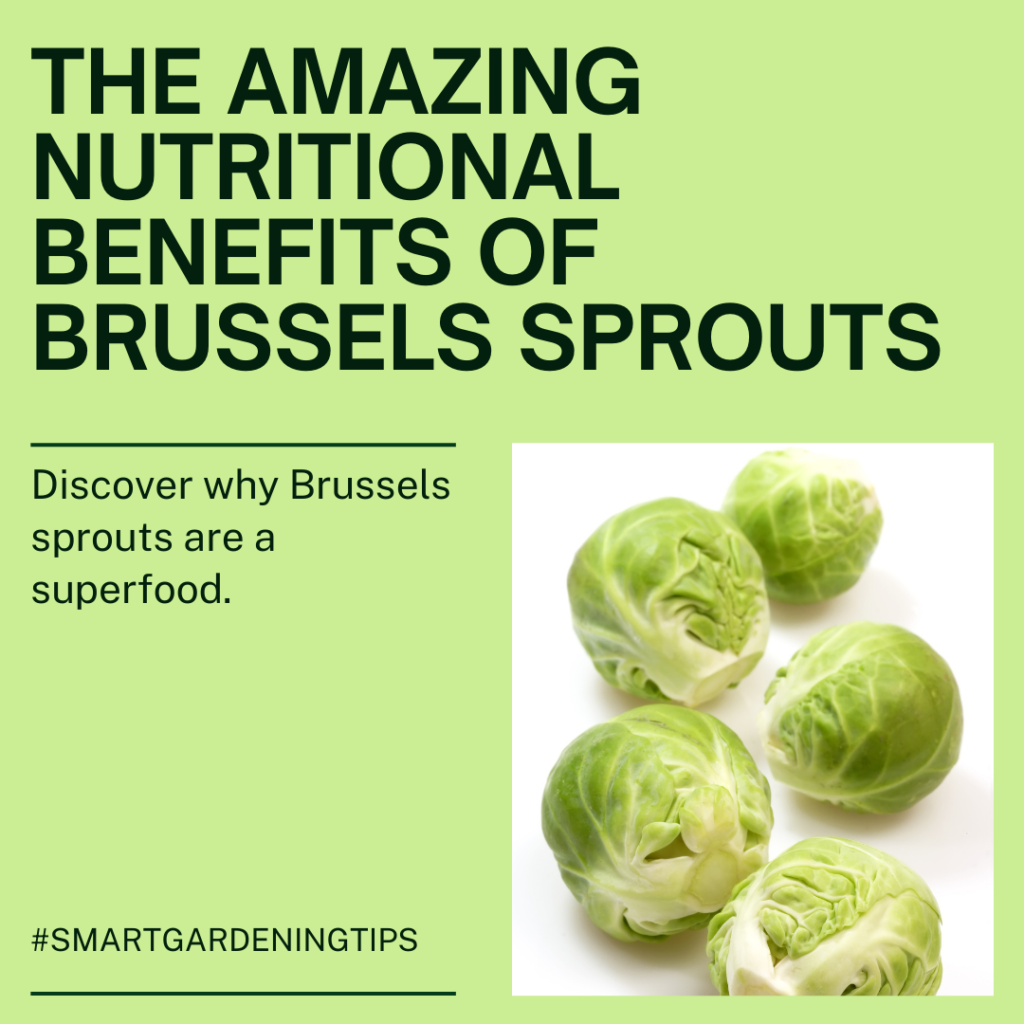
Brussels sprouts are not only delicious but also packed with an array of nutritional benefits that can contribute to a healthy diet. These miniature cabbage-like vegetables are a rich source of vitamins and minerals, making them a valuable addition to any balanced meal.
1. High in Vitamin C
One of the standout nutritional benefits of Brussels sprouts is their high vitamin C content. Vitamin C is known for its immune-boosting properties and its ability to protect against oxidative stress. Including Brussels sprouts in your diet can help support a strong immune system and promote overall well-being.
2. Excellent Source of Fiber
Brussels sprouts are an excellent source of dietary fiber, which plays a crucial role in maintaining a healthy digestive system. Fiber helps promote regular bowel movements and can help prevent constipation. It also contributes to a feeling of fullness, which can assist in weight management.
3. Abundance of Antioxidants
The nutritional benefits of Brussels sprouts extend further with their abundance of antioxidants. Antioxidants are compounds that help protect cells from damage caused by free radicals, which can contribute to chronic diseases. Brussels sprouts are particularly rich in antioxidants such as vitamin A, vitamin E, and various flavonoids.
“Including Brussels sprouts in your meals can provide a significant boost of antioxidants, helping to protect your body against oxidative stress and reduce the risk of chronic diseases.”
4. Rich in Vitamins and Minerals
Brussels sprouts are a nutrient-dense vegetable, providing a wide range of vitamins and minerals essential for optimal health. They are an excellent source of vitamin K, which plays a crucial role in blood clotting and bone health. Additionally, Brussels sprouts contain significant amounts of vitamin A, manganese, folate, and potassium.
“By including Brussels sprouts in your diet, you can nourish your body with a variety of essential vitamins and minerals necessary for maintaining overall health and well-being.”
5. Potential Cancer-Fighting Properties
Emerging research suggests that Brussels sprouts may possess cancer-fighting properties. They contain compounds called glucosinolates, which are associated with a reduced risk of certain types of cancer. Glucosinolates are metabolized into substances that have been shown to inhibit the growth of cancer cells and promote their destruction.
6. Heart-Healthy Benefits
Brussels sprouts can contribute to heart health due to their high fiber content, which helps lower cholesterol levels. They are also a good source of potassium, a mineral that assists in maintaining healthy blood pressure levels. Including Brussels sprouts in your diet can support a heart-healthy lifestyle.
7. Weight Management Aid
If you are looking to maintain a healthy weight or shed a few pounds, Brussels sprouts can be a valuable asset. These vegetables are low in calories and high in fiber, helping you feel full and satisfied with fewer calories consumed. They can be a nutritious and filling addition to any weight management plan.
| Nutrient | Amount Per 1 cup (156g) |
|---|---|
| Calories | 56 |
| Fiber | 4 grams |
| Vitamin C | 75% of the Daily Value (DV) |
| Vitamin K | 137% of the DV |
| Vitamin A | 18% of the DV |
| Potassium | 14% of the DV |
These nutritional benefits only scratch the surface of what Brussels sprouts have to offer. Including these versatile vegetables in your meals can provide a tasty and nutritious boost to your overall well-being.
Now that you know about the nutritional benefits of Brussels sprouts, it’s time to explore some delicious recipes and creative ways to incorporate them into your diet. The possibilities are endless when it comes to enjoying the wholesome goodness of Brussels sprouts.
Fun Facts and Trivia about Brussels Sprouts
Did you know that Brussels sprouts have a fascinating history and unique characteristics? Discover some fun facts and trivia about these delicious little vegetables!
The Origins of Brussels Sprouts
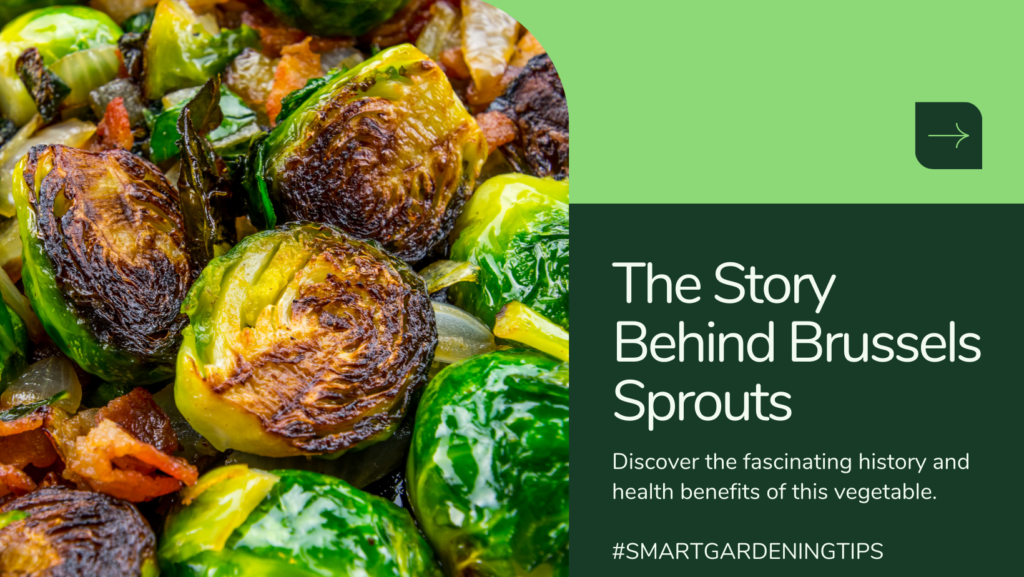
Brussels sprouts have been cultivated for centuries and were first grown in ancient Rome. They were later popularized in Brussels, Belgium, hence their name. Today, these tasty sprouts are enjoyed all around the world.
Miniature Cabbages
Brussels sprouts belong to the Brassica oleracea family, which also includes cabbage, broccoli, and kale. These tiny green orbs are actually miniature cabbages that grow on a stalk. Each sprout is packed with flavor and nutrients.
A Winter Vegetable
Brussels sprouts thrive in cooler temperatures and are often associated with winter dishes. They are typically harvested in late fall and early winter, making them a popular addition to holiday feasts.
Surprising Nutritional Powerhouses
Despite their small size, Brussels sprouts are nutritional powerhouses. They are an excellent source of vitamins C and K, as well as folate and fiber. These nutrients contribute to a healthy immune system and can support digestion and overall well-being.
A Versatile Ingredient
Brussels sprouts are incredibly versatile and can be enjoyed in a variety of ways. They can be roasted, sautéed, steamed, or even eaten raw in salads. Their slightly bitter flavor pairs well with a range of ingredients, from tangy balsamic vinegar to savory bacon.
Record-Breaking Sprouts
In 2019, a farmer in the United Kingdom grew the world’s largest Brussels sprout, weighing in at a whopping 19.95 pounds (9.045 kilograms). This incredible achievement showcased the impressive potential of these humble vegetables.
A Popular Modern Trend
In recent years, Brussels sprouts have gained popularity as a trendy ingredient. Chefs have reinvented the sprout by incorporating them into unique dishes like Brussels sprout pizza, Brussels sprout chips, and even Brussels sprout ice cream.
Brussels Sprouts Superstitions
Brussels sprouts have also inspired some interesting superstitions. In some cultures, it is believed that eating Brussels sprouts on New Year’s Day will bring good luck and prosperity for the year ahead. So why not add them to your New Year’s menu?
Now that you know these fascinating fun facts and trivia about Brussels sprouts, you’ll appreciate these delicious miniature cabbages even more. Whether you enjoy them roasted, steamed, or in creative recipes, Brussels sprouts are a nutritious and flavorful addition to any meal.
FAQ
Q. How do I select the right Brussels sprouts varieties?
A. When choosing Brussels sprouts varieties, consider factors such as taste, size, and growing conditions. Popular varieties known for their taste include ‘Diablo’ and ‘Long Island Improved’.
Q. What are the steps to plant Brussels sprouts in my garden?
A. To plant Brussels sprouts, start by preparing the soil, sowing the seeds or transplanting seedlings, and providing proper care such as regular watering and fertilization.
Q. When and how should I harvest Brussels sprouts?
A. Harvest Brussels sprouts when they are firm and about 1 to 1.5 inches in diameter. Simply twist or cut off the sprouts from the stalk, starting from the bottom.
Q. How can I store Brussels sprouts to maintain their taste and freshness?
A. To store Brussels sprouts, remove any loose or discolored leaves, place them in a perforated plastic bag, and store them in the refrigerator. They can stay fresh for up to two weeks.
Q. What are some creative and tasty recipes to make with Brussels sprouts?
A. You can try roasting Brussels sprouts with olive oil and garlic, sautéing them with bacon and balsamic vinegar, or adding them to stir-fries and salads for a delicious and nutritious meal.
Q. How can I enhance the flavor of Brussels sprouts when cooking?
A. Enhance the flavor of Brussels sprouts by adding ingredients like butter, lemon juice, Parmesan cheese, or spices such as garlic, paprika, or thyme. You can also try different cooking methods like roasting or grilling.
Conclusion
Throughout this article, we have explored the art of cultivating tasty Brussels sprouts. From selecting the right varieties to planting, caring, and harvesting, we have provided you with the knowledge and techniques needed to grow your own flavorful sprouts.
By following these guidelines and using organic cultivation methods, you can enhance the taste of your Brussels sprouts and enjoy the satisfaction of homegrown produce. Not only are Brussels sprouts packed with essential nutrients, but they also offer a range of delicious cooking possibilities.
So, why not embark on a journey to transform your garden into a Brussels sprouts haven? With a little dedication and care, you can savor the delectable flavors that homegrown Brussels sprouts have to offer. Start your Brussels sprouts adventure today and enjoy the gratifying taste of your own bountiful harvest.
















